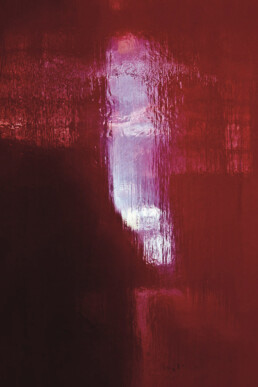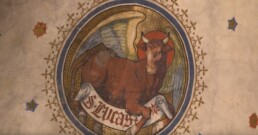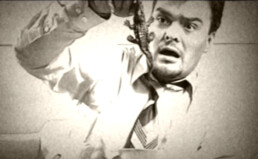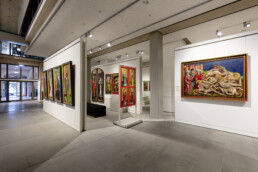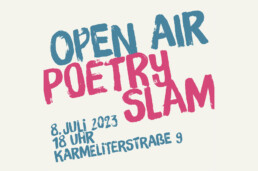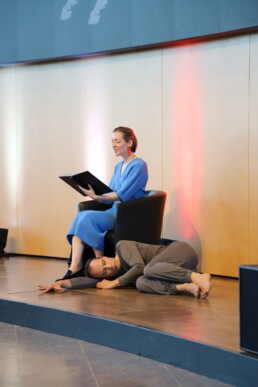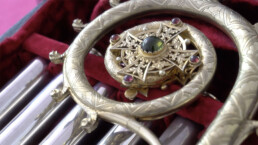Taube, Fisch und Auto – Ein überraschendes Trio
Wer kennt sie nicht – Aufkleber auf den Heckscheiben oder Kofferraumdeckeln mit allerlei bekannten oder unbekannten Abbildungen. Matthias Raidt hat davon auch welche entdeckt und erforscht deren Aussagen. Welche es sind? Einfach das Video schauen!
Stations of the Cross - Artist talk with Bernhard Langerock
Photographer Bernard Langerock has selected 15 works from his extensive photo series "Cross Phenomena" and compiled them into Stations of the Cross. In his texts, Dr Kurt-Peter Gertz, theologian and art historian, takes an associative look at the result of this work, a rare form of depiction of the Stations of the Cross in the art world.
The open combination of image and word gives viewers the opportunity to develop their own ideas and thoughts and to immerse themselves meditatively in the photographs.
The depiction of the Way of the Cross goes back to the "Via dolorosa", Jesus' historical path of suffering from his condemnation to his crucifixion on Calvary in Jerusalem.
The artist talks to Dr Melanie Prange about the exhibited works and the Stations of the Cross in the history of art and piety.
Bernard Langerock, Photo artist
Dr. Melanie Prange, Director of the Rottenburg Diocesan Museum, Diocesan Conservator
Thursday, 04.04.2024, 19:00 - 20:30
House of the Catholic Church, Stuttgart
Entrance free
Registration takes place via the homepage of the Katholisches Bildungswerk Stuttgart:
Registration "Stations of the Cross - Artist talk with Bernhard Langerock"
Further information on the "Stations of the Cross" exhibition can be found on the homepage of the Katholisches Bildungswerk Stuttgart:
https://www.kbw-stuttgart.de/veranstaltungen/290224-kreuzweg-stationen/
EinBlick in...
Beastly awesome – Creatures from another world
In the churches you often find monstrous creatures that make you think more of a fantasy film. Where do these creatures come from and why are they found in churches of all places?
Watch our new episode of Crucifix – Fascination & Facts now and find out.
Photo: Holy Cross Minster, Rottweil,© Diocese of Rottenburg Stuttgart
Tangible delicate | Finissage with film derby
Until mid-October, our exhibition “Tangible delicate” shows the glass, metal and alabaster sculptures of the renowned Berlin sculptor Susanne Roewer. With a high degree of sensuality and irrepressible power, the artist creates works that seem primordial and futuristic at the same time. The dream-like figures combine pressing political-social themes with religious and literary references. Sometimes her installations are light and airy, characterised by transparency and a shimmering sheen, sometimes they are iron and heavy, firmly adhering to the ground. They show the viewer a world outside the everyday, where opposites meet and living things are created from inorganic matter.
For the exhibition’s finissage on Saturday, 14 October at 5 p.m., Susanne Roewer will once again come to Rottenburg for a cosy evening with film derby. A series of short films and film snippets of an artistic nature are shown in the museum. There is time for snacks and a glass of wine before, between and after the films.
Image caption:
Christian Bahrmann, Wolfgang Schilke and Susanne Roewer
Film still: Between two cups of coffee
(n. y.)
Reichenau Artists’ Days
Ideas of what is sacred have always sought and continue to seek the proximity of the language of art in order to articulate themselves. The “sacred” can initially be understood very openly – with the sociologist of religion Hans Joas as that which can in some way take hold, that which is able to pull individuals or communities beyond themselves. And in such experiences of “self-delimitation or self-exaggeration” then lies an “affective certainty”: a certainty in which – “binding force” develops “whose strength goes beyond everyday experiences” (Hans Joas, Die Macht des Heiligen, 2017, p. 434).
Art can therefore be understood as opening a sensual access to the permanently nonsensual sacred, evoking in a corporeal-material sense, paradoxically representing the transcendent: in its unrepresentability. Art that sees itself in this way is always more than a visual or perceptual object. Their works are powerful media and make themselves and something OTHER appear. They awaken imagination and imagination that goes beyond what is shown, they construct, envision, stage and iconise. That which is thus represented is present and absent at the same time: traces … traces.
The Reichenau Artists’ Days 2023, for which the Kunstverein der Diözese Rottenburg-Stuttgart is responsible, will go in search of traces through listening, seeing, exchanging and reflecting. A search for traces, which the conference will by no means lead to a goal, but which should perhaps be opened at the very beginning. The programme sketches a possible horizon of such a common search for traces and wants to inspire to get involved in corresponding paths.
The preparation team and the board are looking forward to being together in Hersberg. We also welcome the members of the Community of Christian Artists from the Archdiocese of Freiburg.
For further information on registration and the programme, please see the attached flyer.
Image caption:
Marie Lienhard
Video still: gold explosion (Excerpt)
© VG Bild-Kunst, Bonn 2023
Das Diözesanmuseum sucht eine Museumsaufsicht (m/w/d)
Für das Diözesanmuseum Rottenburg suchen wir zum nächstmöglichen Zeitpunkt
eine Museumsaufsicht (m/w/d)
(in Teilzeit 40%, derzeit 15,8 Wochenstunden)
befristet bis 31.07.2024
Das Diözesanmuseum Rottenburg beherbergt sakrale Kunst vom 2. bis 21. Jahrhundert, darunter Werke von europäischem Rang. Neben den Gemälden und Skulpturen des Mittelalters, des Barock und der Moderne, verfügt die Sammlung über herausragende Zeugnisse der Metallkunst, hochwertige Paramente, eine in Umfang und Qualität einzigartige Sammlung von historischen Gläsern, zahlreiche Grafiken, Münzen- und Medaillen sowie vielfältige Zeugnisse der religiösen Volksfrömmigkeit.
Ihre Aufgaben sind insbesondere:
- Aufsicht im Museumsraum
- Betreuung des Kassenbereichs mit Museumsshop
- Besucherinformation und Besucherleitung
- Flexibler Einsatz bei Sonderveranstaltungen (z. B. Getränkeausschank)
Sie bringen mit:
- Interesse am Kulturbetrieb
- Zuverlässigkeit
- Kontakt- und Kommunikationsfreude
- Teamfähigkeit
- Flexibilität
- Fremdsprachenkenntnisse wären von Vorteil
- Bereitschaft, sich in Kenntnisse zur Sammlung einarbeiten zu lassen
Wir bieten Ihnen ein abwechslungsreiches Tätigkeitsfeld und die im öffentlichen Dienst üblichen Sozialleistungen wie z.B. Zusatzversorgung aus der ZVK. Das Angestelltenverhältnis richtet sich nach der Arbeitsvertragsordnung der Diözese Rottenburg-Stuttgart (AVO-DRS), vergleichbar dem Tarifvertrag des öffentlichen Dienstes der Länder (TV-L). Die Eingruppierung erfolgt in Entgeltgruppe 2.
Die Identifikation mit der katholischen Kirche und die Zugehörigkeit zu einer Kirche der christlichen Kirchen (ACK) setzen wir voraus.
Schwerbehinderte Menschen werden bei gleicher Eignung bevorzugt berücksichtigt.
Ihre Bewerbung richten Sie bitte per Mail/per Post bis zum 31.10.2023 an das Diözesanmuseum Rottenburg, Karmeliterstraße 9, 72108 Rottenburg. Ihre Ansprechpartnerin ist Frau Dr. Melanie Prange, Telefon 07472/ 922-181, E-Mail mprange@bo.drs.de. Für Fragen zum Arbeitsrecht steht Ihnen Frau Birgit Saile-Leins, Telefon 07472/169-650, E-Mail bisaileleins@bo.drs.de zur Verfügung.
Tangible delicate – Vernissage with Poetry Slam
A world full of poetry
The Diocesan Museum’s garden and exhibition spaces will be the scene of bold contrasts and surprising encounters this summer. From fragile glass bubbles clinging to rough alabaster surfaces to bronze figures radiating gentle delicacy – in the works of Susanne Roewer, the most diverse, seemingly incompatible materials come together to form a poetic unity. The exhibition Tangible delicate (8 July – 14 October 2023) in Rottenburg shows sculptures and installations by the Berlin sculptress that defy the rules of gravity and enchant the viewer with their grace and powerful fragility.
We cordially invite you to the opening of the exhibition with a poetry slam on Saturday, 8 July, 6 pm!
Poetry slam is performed stage literature. Different poets from all over Germany will meet in the garden of the museum and seminary. A firework of poetry and prose, sometimes performed loudly, sometimes quietly. And as always, the audience decides who wins the evening.
The evening will be moderated by Asli Kücük, Landestheater Tübingen, and Wehwalt Koslovski, poetry slam pioneer and world champion. Since 1994, Koslovski has performed over 2500 times on stages in Europe, the USA and Japan. He lives and works as a freelance stage poet, reciter, literary organiser, lecture traveller, speech & language coach and art teacher in Berlin.
Creation myths in motion
For all those who could not experience it or would like to experience it again – the performance “Telling of our beginnings. Creation myths in word, music and dance” with Felix Grützner (dance) , Patrick Bebelaar (piano) and Julia Hölzgen (spoken word artist) is now available on YouTube:
Joannes Baptista Sproll and his crosier
Joannes Baptista Sproll becomes Bishop of the Diocese of Rottenburg in 1927. In the first photos, he had himself photographed with the crosier of his predecessor Paul Wilhelm Keppler. Since it was customary in earlier times to take over the staff of one’s predecessor, it was long thought that Sproll did not have one of his own. But how could this be done during his time as auxiliary bishop? Did Bishop Keppler and Auxiliary Bishop Sproll agree at the weekend who could use the baton and when? Inconceivable, says diocesan archivist Dr Herbert Aderbauer and sets out to find out.

